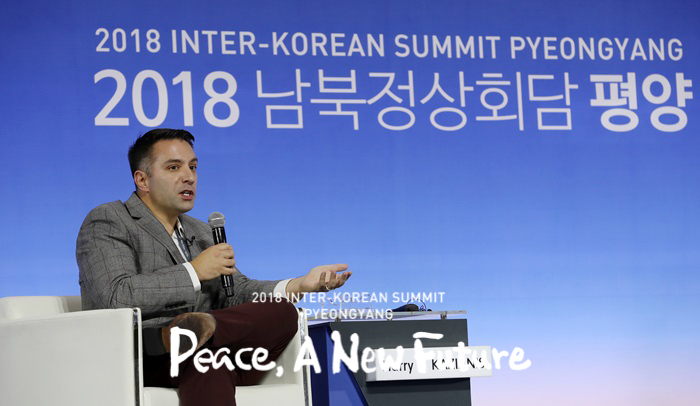Korean Peninsula experts discuss Pyeongyang Joint Declaration

Harry Kazianis, director of defense studies at the Center for the National Interest, shares his thoughts about the Pyeongyang Joint Declaration of September 2018 during a special conference at the Seoul press center for the 2018 Inter-Korean Summit Pyeongyang on Sept. 19. (Pyeongyang Press Corps)
By Pyeongyang Press Corps
The Pyeongyang Joint Declaration of September 2018 includes milestone agreements between the two Koreas, including the dismantlement of the Dongchang-ri missile engine test site and launch platform, the permanent dismantlement of the nuclear facilities in Yeongbyeon, and a possible visit to Seoul by North Korean Chairman Kim Jong Un. All of this has garnered a good deal of rave reviews from both Korean and non-Korean experts concerning issues on the Korean Peninsula.
Moon Chung-in, a special advisor to President Moon Jae-in who is currently in Pyeongyang as part of the 2018 Inter-Korean Summit Pyeongyang special delegation, said in a briefing held right after the announcement of the declaration at the Pyeongyang press center on Sept. 19 that, “The two sides share a common starting point: prevent random conflicts on the Korean Peninsula, which, in turn, could lead to preventing nuclear conflicts. Through this process, the two Koreas should be able to achieve complete denuclearization on the peninsula.”
“The Pyeongyang declaration is significant in that it has at least the minimum measures that could stop conventional military conflicts in the region,” Moon stressed.
Mentioning the phrase “dismantling the nuclear facilities in Yeongbyeon, as the United States takes corresponding measures,” Moon said that, “It’s the first time, ever, for Pyeongyang to announce its willingness to permanently give up its plutonium- and highly-enriched uranium-producing facilities, which are the foundation of its nuclear weapons.”
“With the Pyeongyang declaration, I think we have a very sound foundation for further nuclear negotiations. A large portion of what the two leaders talked about for more than four hours was things related to nuclear weapons, which is very uncommon.”
Regarding Chairman Kim’s possible visit to Seoul within the year, Moon said, “It’s Kim’s own decision, completely. Many around him opposed this idea, but couldn’t stop him.”
Harry Kazianis, director of defense studies at the Center for the National Interest, defined the Pyeongyang declaration as “a positive step forward.”
“As in the Pyeongyang summit’s official slogan ‘Peace, a New Future,’ I think we’re moving forward to that future,” he said. “This is the third summit between President Moon and Chairman Kim, and we’re slowly getting to bigger and bigger results."
In particular, Kazianis highlighted one of the reasons why the Pyeongyang summit was a success. “The most important thing that has happened at the summit was that there is an ‘inter-Korean relationship.’ It’s a step forward. If you’re going to try to tackle all the issues, we need to have that foundation of an inter-Korean relationship first.”

